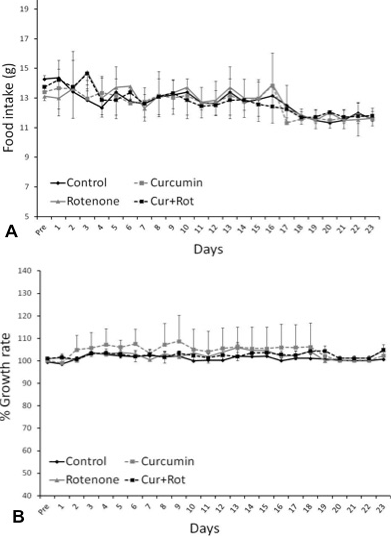Therapeutic Effects of Curcuma longa against Rotenone-Induced Gross Motor Skill Deficits in Rats
Therapeutic Effects of Curcuma longa against Rotenone-Induced Gross Motor Skill Deficits in Rats
Syeda Madiha, Zehra Batool, Saiqa Tabassum, Laraib Liaquat, Sadia Sadir, Tahira Perveen and Saida Haider*
Schematic representation of experimental protocol.
Effects of rotenone and pre-administration of curcumin on food intake (A) and growth rate (B). Values are mean+SD (n=6). Difference was non-significant obtained by one-way ANOVA following Tukey’s test. Growth rate in % was calculated by Present weight/Initial weight x 100).
Rotenone significantly impaired the motor skills in pole test as observed by decreased time to descend indicating reduced muscular strength. This effect was significantly attenuated by pre-administration of curcumin in Cur+Rot group when comparing with rotenone administered rats. Values are mean+SD (n=6). Significant difference was obtained by one-way ANOVA following Tukey’s test. **p<0.01 versus controls and ++p<0.01 versus rotenone injected group (n=6).
Effect of curcumin on muscular strength for all four paws was assessed by Kondziela test. Rotenone impaired the muscular strength of rats as observed by significantly decreased time to hold the inverted screen as compared to controls (**p<0.01). 15 days pre-treatment with curcumin attenuated the effects of rotenone on motor coordination as evident by significantly increased inverted screen score in Cur+Rot group as compared to rotenone (n=6) injected rats (++p<0.01). Significant differences were obtained by one-way ANOVA followed by Tukey’s test. Values are mean+SD (n=6).
Effect of prior administration of curcumin (100 mg/kg/day) for 15 days on cataleptic behavior induced by rotenone observed in inclined plane apparatus. Values are mean+SD (n=6). Data was analyzed by one-way ANOVA followed by Tukey’s post-hoc test. Mean values were significantly different from controls (**p<0.01), and rotenone (n=6) injected rats (++p<0.01). The group that underwent successive rotenone administration for eight days exhibited a prominent cataleptic behavior as evident by significant increase in % cataleptic score as compared to control rats. Pre-treatment with curcumin significantly normalized these observed parameters in Cur+Rot group. Cataleptic score in % was calculated by (latency to move/total time) x 100).
Open field activity was performed to monitor the ambulatory activity in rats. Rotenone affected the motor skills of the rats and significantly decreased (A) latency to move, (B) number of squares crossed confirming the loss of motor activity. Values are represented as mean+SD (n=6). Data was analyzed by Tukey’s test following one-way ANOVA. Mean values were significantly different than that for controls (**p<0.01, *p<0.05) and rotenone (n=6) injected rats (++p<0.01, +p<0.05).
Beam test was performed to assess the motor coordination. Subcutaneous injection of rotenone affected the motor coordination and significantly increased the time to cross the beam in all three beams of varying diameters as compared to control rats, confirming the loss of motor skills. Pre-treatment with curcumin significantly normalized the impaired motor activity in Cur+Rot group. Significant differences were obtained by one-way ANOVA followed by Tukey’s post hoc test. **p <0.01 as compared to controls and ++p<0.01 when compared with rotenone injected group (n=6). Values are mean+SD (n=6).
Foot pattern of rats was attained by footprint test. (A) representation of footprint pattern analysis. Forepaws and hindpaws were coated with red and green ink, respectively. The dotted lines indicate stride length. The irregular distance between the fore- and hindpaws in Rot administered rat is encircled whereas symmetrical foot pattern is encircled in Cur+Rot administered rat. The quantification of strides (B) and base width (C) in control (n=6) and test (n=6) groups. Values are mean+SD (n=6). Data was analyzed by one-way ANOVA followed by Tukey’s post-hoc test. Mean values were significantly different from controls (**p<0.01), and rotenone (n=6) injected rats (++p<0.01).
The retention time of dopamine (DA) and dihydroxyphenyl acetic acid (DOPAC) in standard solution (A) and striatal brain region (B) of rats representing by HPLC chromatogram. Effect of prior administration of curcumin (100 mg/kg/day) for 15 days on neurotransmitter levels (C). DA (ng/g of brain tissue) and DOPAC (ng/g of brain tissue) levels were analyzed at the end of present study. Significant differences were obtained by one-way ANOVA following Tukey’s test. **p<0.01 versus controls and ++p<0.01 versus rotenone injected group (n=6).
Effect of rotenone and curcumin pre-treatment on striatal ACh (µmol/g) levels and AChE (mmol/g/min) activity. Significant differences were obtained by one-way ANOVA following Tukey’s test. **p<0.01 versus controls and ++p<0.01 versus rotenone injected group (n=6).
Estimated MDA (µmol/g of brain tissue) (A) and GSH (nmol/g of brain tissue) levels (B) various enzyme activities followed by s.c. injection of rotenone. Enzymes activity such as SOD (U/g of brain), CAT (µmol/min/g of brain tissue), and GPx (µmol/min/g of brain tissue) were also estimated to determine the effects of 15 days curcumin pre-treatment on rotenone-induced oxidative stress. Significant differences were obtained by one-way ANOVA following Tukey’s test. **p<0.01 versus controls and ++p<0.01 versus rotenone injected group (n=6).




















